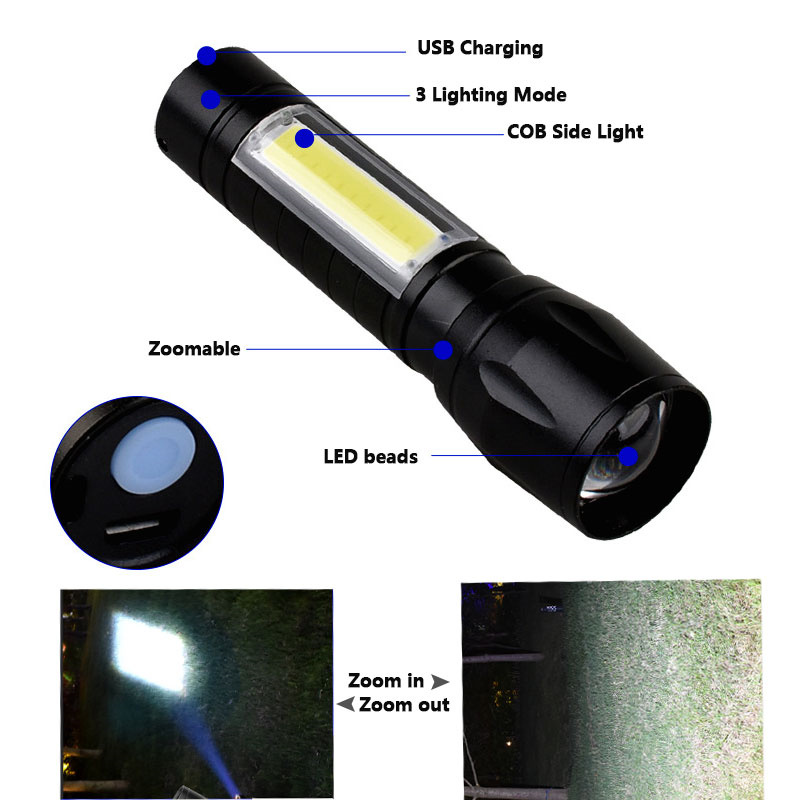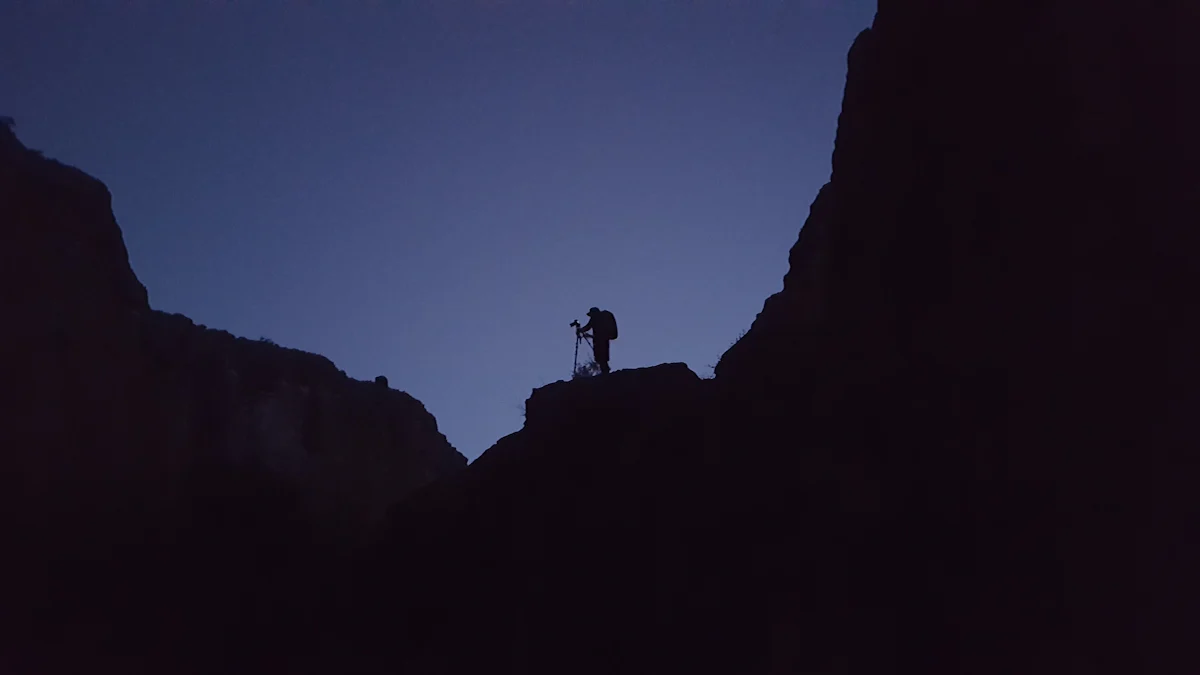How Flashlights Can Improve Safety in Climbing and Mountaineering Activities

Climbing and mountaineering can be thrilling, but they come with risks, especially when light fades or conditions change. Understanding how flashlights can improve safety in climbing and mountaineering activities is crucial. A flashlight is essential gear that keeps you prepared for the unexpected. It boosts visibility, helping you navigate tricky paths and avoid hazards. In emergencies, it becomes a lifeline, signaling for help when needed. Choosing the right flashlight ensures you stay safe and confident during your adventures. A high-quality flashlight isn’t just a tool—it’s your partner in outdoor safety. Don’t underestimate the importance of a flashlight when planning your next climb.
Key Takeaways
A flashlight is important for seeing in the dark. It helps you spot the path and stay safe from dangers.
In emergencies, a flashlight can ask for help. Use blinking or flashing lights to help rescuers find you.
Pick a strong flashlight that works in bad weather. Make sure it is waterproof and won't break easily.
Think about battery life when picking a flashlight. Bring extra batteries so it works when you need it.
Choose light and hands-free options, like headlamps. They let you use your hands for climbing or other activities.
Addressing Safety Challenges with Flashlights

Navigating in Low-Light Conditions
When you're out in the wilderness, the sun doesn't always work on your schedule. Low-light conditions can sneak up on you, especially during early mornings, late evenings, or when the weather turns cloudy. A flashlight becomes your best friend in these moments. It helps you see the trail clearly, even when you're navigating in the dark. Whether you're climbing a steep rock face or trekking through dense forests, the beam of light ensures you stay on track. Without it, you risk losing your way or stepping into dangerous terrain. A reliable flashlight gives you the confidence to keep moving forward, no matter how dim the surroundings get.
Emergency Signaling in Critical Situations
Emergencies can happen when you least expect them. In the wilderness, being able to signal for help quickly can make all the difference. Flashlights are excellent tools for emergency signaling. If you're injured, lost, or facing a sudden storm, you can use your flashlight to send out an SOS signal. Many flashlights come with strobe or flashing modes designed specifically for this purpose. These signals are visible from long distances, even in challenging conditions. By using your flashlight effectively, you increase your chances of being spotted by rescuers or fellow climbers. It's a simple yet powerful way to stay safe in critical situations.
Avoiding Hazards and Obstacles in the Dark
The wilderness is full of surprises, and not all of them are pleasant. Rocks, roots, and uneven ground can easily trip you up if you can't see them. A flashlight helps you spot these hazards before they become accidents. It improves your visibility, allowing you to carefully navigate tricky paths and avoid injuries. Preventing accidents and hazards is especially important when you're mountaineering or climbing, where a single misstep can have serious consequences. With a flashlight in hand, you can focus on your journey without constantly worrying about what lies ahead in the dark.
Key Features of Flashlights for Outdoor Safety
Brightness and Beam Distance
When you're out in the wild, the right level of brightness can make all the difference. A flashlight's brightness, measured in lumens, determines how much light it produces. For most climbing and mountaineering activities, a flashlight with 400 to 1000 lumens is perfect. It provides enough illumination to see up to 200 meters, which is ideal for hiking or exploring caves. If you're tackling extreme conditions or need extra visibility, a high-lumen flashlight with 1000 to 3000 lumens can cover distances up to 350 meters. Here's a quick guide:
Lumens | Distance | Best For |
|---|---|---|
400–1000 | Up to 200 meters | Hiking, backpacking, caving |
1000–3000 | Up to 350 meters | Rock climbing, fishing, hunting |
3000–7000+ | Up to 500 meters | Emergency rescue, extreme weather |
Choosing the right flashlight with adjustable brightness settings ensures you can adapt to different low-light conditions and maintain outdoor safety.
Durability and Weather Resistance
Your flashlight needs to handle whatever nature throws at it. Look for models made from tough materials like aluminum or stainless steel. These materials ensure your flashlight can withstand drops and rough handling. Many LED flashlights are also waterproof and shockproof, so they keep working even in rain or snow. Some are designed to resist extreme temperatures, making them reliable in harsh environments. Whether you're climbing in freezing conditions or navigating a storm, a durable flashlight won't let you down.
Battery Life and Power Options
A flashlight is only as good as its batteries. You want a flashlight that lasts through your adventure without running out of power. Lithium primary batteries are a great choice because they perform well in harsh conditions and have a long shelf life. They're perfect for flashlights you might not use often but need to work when it matters. Rechargeable NiMH batteries are another solid option, especially in cold weather. They save you money and reduce waste, making them a practical choice for outdoor adventures. Always carry spare batteries to stay prepared for the unexpected.
By focusing on these key features—brightness, durability, and battery life—you'll be well-equipped for any challenge. Choosing the right flashlight ensures you're ready for whatever your adventure throws at you.
Lightweight and Hands-Free Designs
When you're climbing or mountaineering, every ounce of gear matters. A heavy flashlight can weigh you down and make your journey more exhausting. That's why lightweight designs are a game-changer. They reduce the strain on your pack and let you move more freely. You’ll appreciate this when you're scaling steep cliffs or trekking long distances. A compact flashlight fits easily into your gear without taking up much space, making it a practical choice for outdoor adventures.
Hands-free options, like headlamps, take convenience to the next level. Imagine trying to climb a rock face while holding a flashlight. It’s not just awkward—it’s dangerous. A headlamp frees up your hands so you can focus on climbing safely. It stays securely on your head, directing light exactly where you need it. Whether you're setting up camp in the dark or navigating tricky terrain, a hands-free design keeps your hands available for more important tasks.
Modern LED technology makes these designs even better. LEDs are lightweight, energy-efficient, and incredibly bright. They provide consistent illumination without adding bulk to your gear. Many headlamps with LED lights also offer adjustable straps and tilt features, giving you more control over where the light shines. This flexibility ensures you’re always prepared, no matter the situation.
Choosing a lightweight and hands-free flashlight isn’t just about comfort—it’s about safety. It allows you to move confidently and focus on the challenges ahead. When every step counts, having the right gear can make all the difference.
Practical Tips to Stay Safe with Flashlights
Battery Conservation Strategies
When you're out on a climb or trek, conserving your flashlight's battery life is crucial. You don't want to be left in the dark when you need it most. Here are some simple strategies to keep your flashlight running longer:
Avoid extreme temperatures. Store your flashlight in a cool, dry place to protect the batteries and internal components.
Turn off the flashlight when not in use. Use it only when necessary to save power.
Use the right batteries. Stick to the manufacturer-recommended batteries for optimal performance and to avoid damage.
Replace old batteries regularly. This prevents leaks and ensures your flashlight is always ready.
Remove batteries during long storage periods. If you won't use your flashlight for a while, take the batteries out to prevent corrosion.
For rechargeable flashlights, follow proper charging techniques. Use a quality charger and avoid overcharging to extend battery life. These small steps can make a big difference when you're navigating in the dark.
Emergency Preparedness and Backup Plans
Being prepared for emergencies is essential for your safety during outdoor adventures. A flashlight is a key part of any emergency preparedness plan. Here's how you can stay ready:
Choose a flashlight with high brightness (200 lumens or more) and long battery life for better visibility in critical situations.
Carry spare batteries in a cool, dry place. Rotate them periodically to keep them fresh.
Test your flashlight regularly to ensure it's working properly. A quick check before every trip can save you from surprises.
Keep your flashlight in an accessible location. You don't want to waste time searching for it during an emergency.
Consider a backup flashlight. A compact, lightweight model can serve as a reliable spare.
These steps ensure you're ready to handle unexpected situations, whether it's signaling for help or preventing accidents and hazards on the trail.
Proper Maintenance and Storage
Taking care of your flashlight ensures it stays reliable for years. Regular maintenance is simple but effective:
Clean your flashlight every six months to remove dirt and debris. This keeps it performing at its best.
Store it in a cool, dry place to avoid damage from moisture or extreme temperatures.
Use a protective case for high-end flashlights. This shields them from physical damage and dust.
Remove the batteries when not in use. This prevents corrosion and extends the life of your flashlight.
If you use your flashlight daily, check it monthly. For less frequent use, a bi-yearly inspection works well. Proper care keeps your flashlight ready for any adventure.
The Importance of a Flashlight for Climbing and Mountaineering

Reliability in High-Stakes Situations
When you're in the wilderness, you can't afford to take chances. A reliable flashlight becomes your lifeline in high-stakes situations. Imagine you're scaling a mountain, and the sun sets faster than expected. Without proper lighting, every step becomes a gamble. A flashlight ensures you maintain visibility, helping you avoid dangerous missteps or unseen obstacles. It’s not just about convenience—it’s about safety.
Emergencies can strike at any moment. Whether you're caught in a sudden storm or navigating unfamiliar terrain, a dependable flashlight keeps you prepared. Many models come with emergency features like strobe or SOS modes. These functions can signal rescuers from a distance, increasing your chances of getting help quickly. A reliable flashlight isn’t just a tool; it’s essential gear that could save your life when the unexpected happens.
Long-Term Value and Performance
Investing in a high-quality flashlight pays off in the long run. Premium models use advanced LED technology, offering superior brightness and energy efficiency. You’ll find flashlights with multiple brightness modes, so you can adjust the light to suit your needs—whether you're exploring a dark cave or setting up camp. Some even double as power banks, letting you charge other devices during your adventure.
Durability is another key factor. High-end flashlights are built to withstand the harsh conditions of mountaineering. They resist water, shocks, and extreme temperatures, ensuring they perform reliably no matter where you are. Rechargeable batteries in these models last longer and save you money over time. Efficient power management means you won’t have to worry about running out of light when you need it most.
A high-quality flashlight offers more than just functionality. It provides peace of mind, knowing you have a dependable tool that enhances your safety and visibility. When you’re out in the wilderness, having the right gear makes all the difference.
Flashlights are more than just tools—they’re your safety net in the wild. They help you navigate, signal for help, and avoid dangerous obstacles. Always pack a flashlight or headlamp, even if you plan to return before dark. Carry spare batteries and bulbs to stay prepared for the unexpected. Investing in a durable, high-quality flashlight ensures it won’t fail when you need it most. Your safety depends on the gear you choose, so pick wisely. With the right flashlight, you’ll feel confident tackling any climbing or mountaineering challenge. Stay safe and light your way!
FAQ
What type of flashlight is best for climbing and mountaineering?
Look for a durable, lightweight flashlight with at least 400 lumens. A headlamp is ideal since it keeps your hands free. Choose one with adjustable brightness and weather resistance for maximum reliability.
How do I know if my flashlight is waterproof?
Check the IP rating on the flashlight. An IPX4 rating means it’s splash-resistant, while IPX7 or higher ensures it can handle submersion. Always verify this before heading out.
Should I carry a backup flashlight?
Yes, always pack a backup. A compact flashlight or extra headlamp can save the day if your primary light fails. Emergencies happen, and having a spare ensures you’re never left in the dark.
How can I extend my flashlight’s battery life?
Use lower brightness settings when possible. Turn it off when not in use. Store it in a cool, dry place to protect the batteries. Carry spare batteries or a rechargeable power bank for longer trips.
Can I use a regular flashlight for mountaineering?
You can, but it’s not ideal. Regular flashlights may lack durability, brightness, or weather resistance. Outdoor-specific flashlights are designed to handle rugged conditions and provide better safety features.
💡 Tip: Always test your flashlight before your trip to ensure it’s working properly. A quick check can prevent unexpected issues on the trail.
See Also
How to Choose the Ideal Flashlight or Headlamp for Outdoors
Enhance Your Outdoor Safety with Wholesale Mini Pocket Flashlights
Understanding Various Scenarios for Flashlight Use
Comprehensive Guide to Selecting the Right Flashlight for Outdoors
Five Essential Tips for Selecting Your Flashlight or Headlamp
